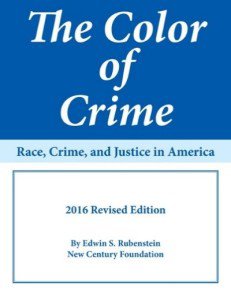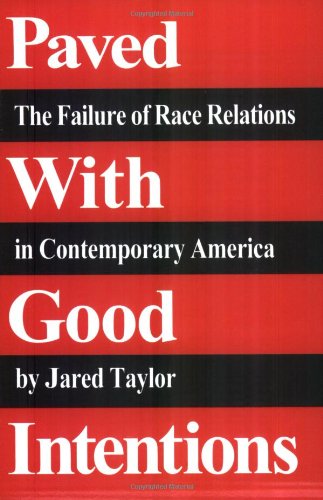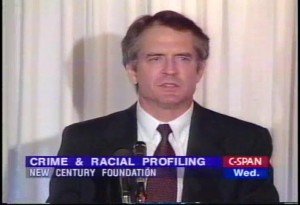[Earlier by Jared Taylor: Color Of Crime, Sound Of (Big Media) Silence and Further Down The Road (Paved With Good Intentions)]
![color2016]() The New Century Foundation, publisher of American Renaissance, is proud to announce its 2016 update of The Color of Crime. This is the definitive account of interracial crime and race differences in crime rates, based unimpeachably on government statistics. The Color of Crime report also covers topical issues such as police shootings of blacks, immigrant crime rates, and the consequences of “de-policing.” Edwin S. Rubenstein, who writes the National Data column for VDARE.com, is the principal author. I believe the report is irrefutable—and an utter condemnation of the Main Stream Media, which has systematically and deliberately suppressed the truth.
The New Century Foundation, publisher of American Renaissance, is proud to announce its 2016 update of The Color of Crime. This is the definitive account of interracial crime and race differences in crime rates, based unimpeachably on government statistics. The Color of Crime report also covers topical issues such as police shootings of blacks, immigrant crime rates, and the consequences of “de-policing.” Edwin S. Rubenstein, who writes the National Data column for VDARE.com, is the principal author. I believe the report is irrefutable—and an utter condemnation of the Main Stream Media, which has systematically and deliberately suppressed the truth.
![Screenshot-2015-06-11-00.55.10[1]]() Here’s an example of The Color of Crime findings:
Here’s an example of The Color of Crime findings:
- Based on current patterns, if New York City were all white, the murder rate would fall by 91 percent and non-fatal shootings would drop by 97 percent. You could lay off most of the police force.
But it’s best just to let the report speak for itself. You can buy a hard copy here for $9.95 or download a free PDF here.
The history of The Color of Crime is worth telling because it is an illuminating commentary on our times.
The first edition of The Color of Crime was published in 1999. What a different era we lived in then! This was during what VDARE.com Editor Peter Brimelow has called “the “interglacial,” that brief thaw between the deep freeze on discussion of race realism and immigration that had set in in the 1960s and returned as an even harder freeze in the early 2000s. It was a fleeting, seven-or eight-year period, during which Brimelow published Alien Nation, ![]() The Bell Curve was a best-seller, my own books were published by mainstream houses, American Renaissance conferences were broadcast on C-SPAN, and it seemed that the country might actually come to grips with the reality of race.
The Bell Curve was a best-seller, my own books were published by mainstream houses, American Renaissance conferences were broadcast on C-SPAN, and it seemed that the country might actually come to grips with the reality of race.
But the hounds of orthodoxy were not sleeping. They had just invented a new name for common sense: “racial profiling.” This was the great sin du jour, much as white privilege and “microaggressions” are some of today’s favorites.
When we released the first edition of The Color of Crime I held a press conference at the National Press Club to explain why racial profiling was rational. I pointed out that everyone knows men commit more violent crime than women, and that young people are more dangerous than old people. We “profile” all the time; an old woman is not the same potential threat as a young man. No one complains when the police “age profile” or “sex profile,” because it would be crazy not to.
I explained that, statistically, racial profiling is no different from sex profiling, since blacks are almost as much more dangerous than whites, as men are more dangerous than women. In big cities, by the way, that’s still very much the case. In Chicago, a man is about 20 times more likely than a woman to be arrested for robbery—and a black is about 27 times more likely than a white.
The country was quite open to a flicker of sanity. My press conference was covered by C-SPAN. [June 2, 1999] (I keep waiting for C-SPAN to purge the file from its archives, but the proof is still there: I once had almost as much hair as Peter Brimelow!) I was then invited on major television programs to talk about racial profiling. Chris Matthews of Hard Ball listened respectfully. Again and again, I explained to television hosts—even to Queen Latifah [December 13, 2000]—that young black men are the most dangerous people in America.
![jared1999]() In those days it was a cinch to get on talk radio. I must have given 50 or 60 interviews about race and crime, and there were massive, enthusiastic call-ins. In several cities, when a radio producer heard me on a rival station he called to get me on his station. Newspapers wrote up the report. The National Association of Police Organizations invited me to speak at its annual conference. [Race Profiling Is Debated At a Meeting For Police, By Michael Janofsky, NYT, August 15, 1999]
In those days it was a cinch to get on talk radio. I must have given 50 or 60 interviews about race and crime, and there were massive, enthusiastic call-ins. In several cities, when a radio producer heard me on a rival station he called to get me on his station. Newspapers wrote up the report. The National Association of Police Organizations invited me to speak at its annual conference. [Race Profiling Is Debated At a Meeting For Police, By Michael Janofsky, NYT, August 15, 1999]
This year, I’m not holding a press conference. It would attract more demonstrators than reporters. C-SPAN would certainly not cover it. Chris Matthews would probably shoot himself before he would ask me to explain why racial profiling is rational.
No one in the conventional media can bear to hear the obvious: that Chicago doesn’t have a gun problem; it has a race problem.
We will be pitching the report’s author, Edwin Rubenstein, to talk radio, but it will be a hard slog.
Anything even approaching the truth about race is too much for today’s coddled blacks and castrated whites. Just this week, students and faculty at Virginia Tech shrieked because the “white nationalist” Charles Murray had been invited to speak on campus—about capitalism.[ Virginia Tech Debates Upcoming Visit by Charles Murray, Inside Higher Ed, March 15, 2016] Harvard Law School decided to junk its crest because it memorializes an 18th-century donor who established Harvard’s first law professorship—but whose family owned slaves [ Harvard Law School to ditch controversial shield, By Steve Annear, Boston Globe, March 14, 2016]
There is no question that compared to just 17 years ago, the country is terrified.
Or I should say the official United States is terrified. There is now almost an unofficial United States—composed of a rich, multi-faceted, dissident media, none of which existed in 1999. Friendly Internet sites, bloggers, podcasters, and tweeters are going to flash the new Color of Crime all around the world. There’s a very good chance more people will see this year’s report than the one from 1999.
I hope you’ll be one of them.
![]() Jared Taylor [Email him] is editor of American Renaissance and the author of Paved With Good Intentions: The Failure of Race Relations in Contemporary America. (For Peter Brimelow’s review, click here.) His most recent book is White Identity. And he has invited Peter Brimelow to speak at the next American Renaissance conference.
Jared Taylor [Email him] is editor of American Renaissance and the author of Paved With Good Intentions: The Failure of Race Relations in Contemporary America. (For Peter Brimelow’s review, click here.) His most recent book is White Identity. And he has invited Peter Brimelow to speak at the next American Renaissance conference.





![Screenshot-2015-06-11-00.55.10[1]](/uploads-old/2015/06/Screenshot-2015-06-11-00.55.101.png)

 In those days it was a cinch
In those days it was a cinch 









